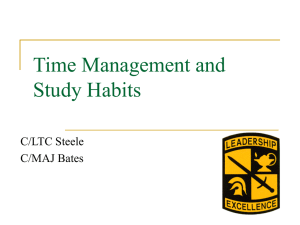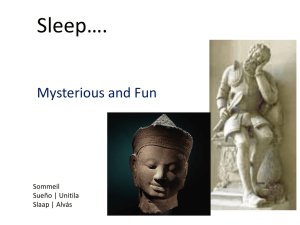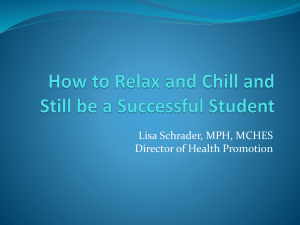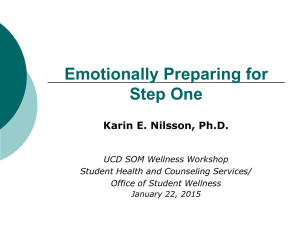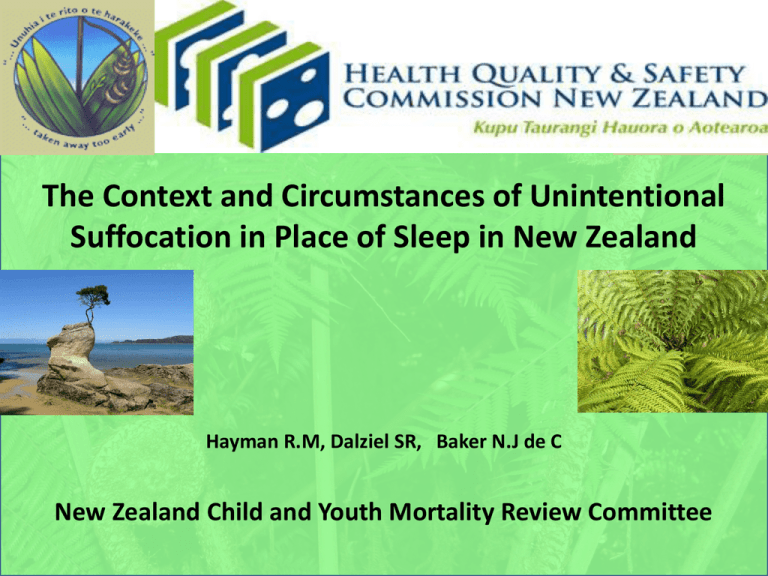
The Context and Circumstances of Unintentional
Suffocation in Place of Sleep in New Zealand
Nic k Baker
Nic k Baker
1
7
Hayman R.M, Dalziel SR, Baker N.J de C
New Zealand Child and Youth Mortality Review Committee
• One National Committee
• 20 local death review groups
• Based on 20 DHBs – “Health States”
• From National Mortality Collection
– Suffocation is 2nd commonest cause of injury death
• after transport
• therefore needed detailed review of suffocation using
national & local information collection
• Focus on part of the results relevant to < 1 yr
Accidental suffocation in place of sleep
- 0 days to 23 mths NZ 2002-2009 (n=152)
25
Number of deaths
Male
Female
20
15
10
5
0
0
1
2
3
4
5
6
7
8
9 10 11 12 13 14 15 16 17 18 19 20 21 22 23
Age in months
Source: CYMRC and PMMRC Cases by ICD-10-AM Underlying Cause of Death as assigned in National Mortality Collection.
Methods
• Broad ICD 10 Search by 14 codes
– Unintentional death by suffocation
– Eight years 2002 – 2009 inc
• 621 cases
– for inclusion 3 independent reviewers sought evidence of
•
•
•
•
death in place of sleep
external compression of the neck or chest or
oro-nasal compression or
blockage of airway with object other than vomit
• 50 meet criteria = categorical suffocation in place of sleep
• Subjected to detailed review
– location, means & circumstance of death
– using mortality data systems, local review, coronial records
Age Distribution
• Forty-eight (96.0%) under 12 months of age
• For under ones average age of death was 3.4 mths.
– range 3 days - 10 months
• Twenty one (42%) under one month
Unintentional Suffocation in
Place of Sleep by Ethnicity
Ethnic
group
Total
2002–
2009 rate
per
100,000
Rate ratio
RR Confidence
interval (95%)
European
10
0.15
1.00
-
Māori
32
1.21
8.22
4.04 - 16.73
Pacific
7
0.67
4.56
1.74 - 11.98
Asian
1
0.08
0.52
0.07 - 4.07
Subtotal
50
0.42
Rate data based on total population under age 25
Location of Death
• Bed and mattress arrangements n = 32 (64%)
– mattresses on floor, bunk beds, beds pulled together,
bean bag, tri-pillow, mixtures, single mattress two people
• Couch or chair n = 9 (18%)
• Cot n = 7 (14%) – six faulty cots
– gaps round mattresses
– faulty cots sides
• slipped through and trapped
• wedged in gap by sagging cot side
Means of Death
• Overlaying n = 30 (60.0%)
• whole or part of a body, limb or breast, can cover the face,
flex the neck or apply pressure to the chest or abdomen
– by mother/father in a co-sleeping situation n = 25 (50%)
– by sibling in a co-sleeping situation n = 4 (8%)
• Wedging n = 20 (40.0%)
– entrapment between a hard sleeping surface and
bedding n=10 (20%) e.g. mattress and cot/bed/couch
– sleeping surface and wall n = 5 (10%)
– couch/cushions/chair n = 5 (10%)
Circumstances of Death
• domestic chaos, mobile families
– safe sleep not a high priority
• cannot find baby after death!
• apparent lack of knowledge about risks and safety
– “stunned amazement” that baby was at risk
•
•
•
•
shared sleep surface n = 34 (68%)
Illness at time of death n = 8 (16%)
pillows, bean bag, “complex” bedding
unaccustomed caregivers
Why was infant in “harms way”?
• routine n = 13 (26%)
• breast feeding n = 8 (16%)
– overlain by mother arm pit, under breast, face covering
• bottle feed n = 3 (6%)
• makeshift sleeping arrangements n = 8 (16%)
– social gatherings, renovations, holiday
– snugly kills
• moved to unsafe space to settle n = 3 (6%)
• nowhere else to sleep – too cold, overcrowded,
• alcohol impaired caregiver n = 4 (8%)
– But data not collected systematically!
SUDI Spectrum in NZ
Infants under one who die without enough distress to alert caregivers
Environmental
Factors
Vulnerability
or Disease
10
SIDS
10
10
10
Vulnerability and Environment Conspire Together
10
10
Suffocation
• Vulnerability or Disease – smoking especially before birth, preterm, growth
retarded, infections, weak, floppy, other diseases
• Environmental factors – face covering, tummy sleeping, chest compression,
neck compression, airway blockage, over heating
Suffocation in Place of Sleep
- Real and Preventable
• “Get suffocation out of no-man's-land”
– As part of SUDI missed by injury prevention workforce
– Can be hidden in SIDS/unascertained as unpalatable
• Engage injury prevention workforce
– By far the commonest cause of injury death under one
– Work needed on consumer product safety
Mortality (%) in infants aged 28 days to < 1 yr
New Zealand 2006–2010 (n=683 deaths)
Other Medical 7.4%
Assault 1.1%
Unintentional injury 2.9%
Missing data 1.7%
Diseases of the nervous
system 3.0%
Infectious and parasitic
disease 6.1%
R95
R95 Sudden
infant death
SIDS
syndrome 18.7%
18.7%
Diseases of the respiratory
system 8.5%
SUDI 39.8%
Certain conditions
originating in the perinatal
period 11.4%
W75
W75
Accidental
Accidental
suffocation
suffocation
in
and strangulation
place
sleep
in bedof15.9%
15.9%
R99 Other ill-defined and
unspecified causes 4.9%
Other 0.3%
Congenital anomalies
18.2%
Consistent and Persistent
Safe Sleep Practices
• Maori community driven solutions
– culturally appropriate, appealing, possible, easy
• Safe sleep for infants reprioritised
– Model and support good practice at every opportunity
• Especially during health care – staff, training skills
• Policy, audit, record keeping
– Antenatal preparation
– Enable safe sleep – make doing the right thing easy
– “we did it with car seats”
• Wahakura, Pepi-pods
– Whole of society priority
• Health curriculum in schools to great grand parents!
• Every baby needs a sober caregiver
Unbroken Journey of Safe Sleep Support
Antenatal – Natal – Postnatal - Infant
1. Needs Assessment
– infant, mum, wider environment
– wishes
– reality of life
2. Planning – with family
3. Action
– every baby has a place to sleep
•
•
•
•
•
Free of people who might overlay the infant
Free of gaps that could trap or wedge
Firm
Flat
Free from objects that might cover the face
– and it is used!
Conclusions
• The unexpected nature of SUDI can lead to the
acceptance that these deaths “just happen” and
families feeling disempowered.
• A substantial proportion of SUDI is preventable
through addressing suffocation risks
• Families have the right to be
– empowered by knowledge of the circumstances in which
suffocation occurs
– supported in having safe environments for infant sleep.
Acknowledgements
•
•
•
•
•
•
•
•
•
•
Dr Rebecca Hayman
Dr Stuart Dalziel
Otago University Mortality Data group
The PMMRC
Local & National CYMRC Coordinators
Local Groups and Chairs
500 plus Agents – Police, CYF, Plunket, St Johns, MOE, NGOs
DHBs
Coroners
HQSC secretariat
• Wedging refers to an infant who was found with face, neck
or chest trapped in a manner that would impede breathing
and compromise the airway. Wedging had to occur
between two sleeping surfaces, such as a mattress and a
cot.
• Overlay refers to the situation where a co-sleeping partner
has caused suffocation.
• Suffocation in place of sleep includes situations where the
whole or part of a body, such as a limb or breast, can cover
the face, flex the neck or apply pressure to the chest or
abdomen of an infant making it harder to breath. Infants
have few mechanisms to protect their own airway because
of soft flexible tissues so even slight pressure on the nose
or face or neck flexing can lead to suffocation.

